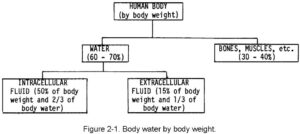2-1. INTRODUCTION
The human body can continue to function much longer without food than without water. Although a person deprived of food for extended periods may experience hunger pangs (and even undergo personality changes), his body will continue to function well enough to permit some use of all faculties. After a time, even this limited use will fade, but this may take weeks or months. The lack of water can cause death within days or even hours (in some cases). The reasons for this situation will be shown in Lesson 2. All animals require a water environment. In the case of marine animals, the water surrounds them. In the case of land animals, the water is carried within the body. Homo sapiens (human beings) are no exception. Water supports life. The lack of water destroys life. The percentages and fractions listed in this lesson may vary, depending on the reference that you consult. This is caused by the different methods of measurement used by the research laboratories. The variations from one reference to another are slight and do not affect the general concept.
2-2. NORMAL FLUID CONTENT IN THE BODY
The average 70 kilogram (or 154 pound) adult male’s body weight is approximately 60 to 70 percent water (see figure 2-1). The more a person weighs (not including body fat), the more water his body contains. The more fat is present in the body, the less will be the total water content per unit of body weight. Fat has almost no water, so fat people have lower water content per pound of body weight than slender people. Water may account for 50 percent or less of their body weight. A newborn infant may have 80 percent of total body weight in water. This proportion decreases gradually as the child grows older and fat is added to the body.
2-3. PROCESSES FOR MAINTAINING WATER BALANCE
The body must maintain fluid balance to achieve homeostasis. The body achieves this balance by adjusting fluid output to equal fluid intake so that the amount of water in the body does not change. We have three sources of fluid intake: the fluids we drink, water in the foods we eat, and water formed by catabolism of tissues. Fluid output is regulated by four organs: the kidneys (which excrete urine), the lungs (which exhale moisture, carbon dioxide, and air), the skin (which excretes perspiration), and the intestines (which excrete moisture in the feces). The volume of urine excreted is the most subject to change. The more fluid the person drinks, the greater the volume of urine excreted; the less fluid consumed, the less the urine flow. This urine regulation is accomplished by a hormone present in the blood stream.
2-4. CATEGORIES OF FLUIDS
Body water is divided into two primary types–intracellular fluid (ICF) and extracellular fluid (ECF). The intracellular is fluid that is contained within the body’s cells. The fluid within the cells makes up about 2/3 of a person’s total body water and accounts for about 50 percent of the person’s body weight. The extracellular fluid is located in the body tissues, bones, and the body’s vascular systems (blood and lymph). The fluids discussed thus far can be depicted as shown in figure 2-1.
a. The intracellular fluid functions in three ways. It transports food within the cells. It brings waste products from the cells so that they can be picked up and excreted from the body. This fluid also maintains the integrity (shape and size) of the cell.
b. The second type of body fluid is the extracellular fluid. The intracellular fluid is located outside the body cells. The extracellular fluid (ECF) comprises approximately one-third of the water contained in the body, and it accounts for approximately 15 percent of a person’s body weight. The extracellular fluid has several functions. It carries nutrients and oxygen to the cells and waste materials from the cells. It serves to bathe the cells in order to keep the cells moist. Two divisions or types of extracellular fluid are interstitial fluid and intravascular fluid. The interstitial fluid surrounds cells and it serves as a transporting medium to carry materials to and from cells. Approximately three fourths of the extracellular fluid is contained in the interstitial fluid. Interstitial fluid accounts for approximately 11 percent of a person’s body weight. The second division of the extracellular fluid is the intravascular fluid (one-fourth of the extracellular fluid). The intravascular fluid is found in the body’s circulatory systems. It accounts for approximately four percent of a person’s body weight (see figure 2-2).
c. Body water diffuses throughout the body without recognizing anatomic boundaries. For example, water passes constantly across the tissue surface of the capillaries. If we could label all the water molecules by the function they were serving at a particular moment (interstitial, intravascular, and so forth), within another minute about half of them would be in another location or serving another function. There is an especially constant circulation of water (and the substance dissolved in it) between the fluids surrounding the cells and the blood.


